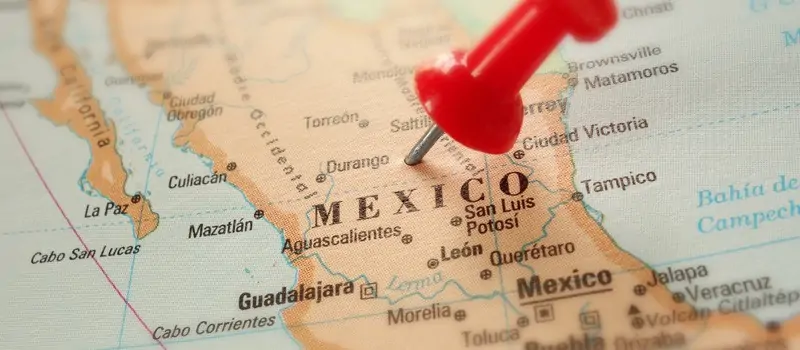If your ethnicity report contains Mexican ancestry DNA results, then this article is for you. Mexican ancestry can be hard to pin down because there are so many possibilities. Mexico is not only home to dozens of indigenous groups, but many others have arrived there in the past five centuries.
The maybe good, maybe bad news is that genealogical DNA testing won’t show your ethnicity as “Mexican.” That’s good, because the label Mexican really doesn’t narrow it down. It’s also bad, because it means you can have ancestors who came from other regions but who lived for many years in Mexico, and your genetic results won’t reflect it. See our complete guide to DNA testing.
Pre-Hispanic Mexico
People have lived in the region that is now Mexico for more than 20,000 years – perhaps as much as 40,000, though that number is hotly debated. However, we know very little about the people who lived there until the Olmec civilization arose about 3,500 years ago, lasting from about 1500 BC to 300 BC. The Olmecs survived for more than a thousand years and left behind extensive ruins, stone carvings, and artifacts.
The Maya civilization emerged somewhere between 750 BC and 500 BC. By 250 AD, they had grown to a number of city-states linked together by a common language, religion, and an extensive trade network. During the ninth century AD, widespread warfare resulted from a collapsing political system and their power as a civilization began to wane. However, the last Mayan city did not fall until 1697, and Mayans remain the second largest indigenous population in Mexico today.
The city of Teotihuacan rose to power around 100 AD and lasted some five to six hundred years. At its height, the city may have housed 200,000 residents, which would have made it the largest city in the Western Hemisphere and one of the largest in the world. However, despite its power and influence, the city remains something of a mystery. Scholars continue to debate how widespread its influence was, and who founded the city. Three possible groups are the Nahua, Otomi, or Totonac peoples. It may even have been a cooperative effort among several groups.
The Toltecs are primarily known through Aztec writings, which identify the Toltecs as their cultural and intellectual predecessors. However, most of those same writings are steeped in mythology, making it extremely difficult to separate fact from fiction. What is clear is that Tula, probably the most important Toltec city, began to decline around 1150 AD, and the Toltec influence with it.
The Aztec Empire had much older roots, but is generally considered to have come to power in 1325 AD with the construction of the city of Tenochtitlan. Ethnically, they were Nahua, who still remain Mexico’s largest indigenous population to this day. The Aztecs’ power and influence was widespread and covered nearly half the population of Mexico. They ruled through military strength and intimidation, which ultimately was their downfall. When the Spanish conquistadors arrived, they found many indigenous people willing to help them overthrow the Aztecs.
Arrival of the Spanish
Following Christopher Columbus’ famous voyage of 1492, news of the “New World” spread across Europe. The Spanish in particular sent fleets of ships to explore, exploit, and colonize this new territory.
Although the Spaniards were vastly outnumbered by the local population, they had several advantages: guns, horses, steel, and the many indigenous allies who chafed under Aztec rule. The first permanent Spanish settlement on mainland America was established in 1510, and in 1521 the conquistadors captured Tenochtitlan, the Aztec capital.
It took another 176 years before the Spanish fully controlled the region. However, the influx of settlers began right away. Thousands of Europeans poured into the area, hungry for new land and new opportunities.
Unlike many other areas colonized during Europe’s Age of Discovery, the Spanish monarchs extended recognition to indigenous nobles and retained the basic city-state structure. Because of this, many indigenous communities kept their local languages, customs, and cultural identity.
Modern borders
The Aztec city of Tenochtitlan became Mexico City under Spanish rule, and has remained the political center of Mexico ever since. Between 1521 and 1810, the Spanish pushed their way outward in every direction until their territory included all of modern Mexico, along with a large portion of the US Southwest.
Beginning in 1810, a decade-long struggle took place to free Mexico from Spain’s control. This was achieved in 1821 when the Treaty of Córdoba was signed. However, the newly-freed Mexico faced many external threats from Spain, France, and especially the United States. In 1846, the Mexican-American War began, ending two years later with Mexico giving up almost half of its total territory to the United States and establishing the current borders.
Ethnicity in Mexico today
Mexico today has a population of just over 126 million people, making it the 10th largest in the world. Of those:
- 47% are “White” Mexicans, ones with predominantly European ancestors
- 25% are Mestizo, who share a mixture of indigenous and European ancestors
- 21.5% are Indigenous, with predominantly indigenous ancestors
- The remainder come from various ethnicities, including Asian, African, and Middle Eastern ancestors
It’s important to note that these are biological classifications, based on genetic tests. In cultural terms, as many as 90% of Mexicans consider themselves Mestizo.
At the time of the Spanish conquest, estimates place the indigenous population of Mexico at about 25 million people. This is about the same number as there are today, 500 years later.
Mexico has more Spanish speakers than any other country in the world. Thanks in large part to the Spanish allowing indigenous communities to continue, it is also the home to more speakers of indigenous languages than anywhere else in North America.
The six largest groups of indigenous peoples in Mexico today are the Nahua, Maya, Zapotec, Mixtec, Otomi, and Totonac. Together with 56 other indigenous groups, they account for more than 20% of the population.
The protections guaranteed to these indigenous groups under the Mexican constitution have also been granted to Native American ethnic groups who originated in the territory of the United States but emigrated southward, including the Kickapoos and Cherokees.
While they make up a small minority, there are about 3.5 million descendants of Africans, Asians, and Middle Easterners living in Mexico as well. Most were transported as slaves to the region between 1565 and 1815 by landowners seeking cheap labor. They came from a wide range of countries, including Lebanon, Syria, Iraq, Palestine, China, Korea, Japan, Malaysia, the Philippines, Java, Cambodia, India, and more.
It’s interesting to note that the ships carrying these passengers travelled both directions, and many Mexicans sailors ended up staying in other countries, the Philippines in particular.
Tracing Mexican ancestors
The ethnicity report you receive from a genealogical DNA test may or may not help you identify Mexican ancestors. If your ancestors were largely from the indigenous peoples of the area, that will certainly show up. Smaller percentages may indicate Mestizo ancestors.
However, it is just as likely that your Mexican ancestors may show up as European, or even African, Asian, or Middle Eastern. If so, they may not provide any clues to your Mexican heritage. Ultimately, the only way to be sure is through traditional research.



